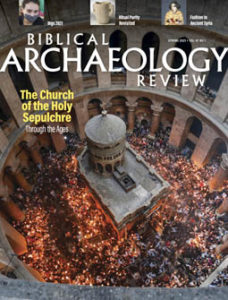The Other Upper Room
Site-Seeing
Jonathan Klawans March 25, 2021 1 Comments 19557 views Share
 The traditional location of the Last Supper—the Crusader era “Upper Room,” known also as the Cenacle—has one thing going for it: height. The only location-specific information we can pull from the various Last Supper accounts is that Jesus and his apostles secured a large furnished space, the upper room of an unnamed (and presumably wealthy) householder in Jerusalem (Mark 14:12-16). The Cenacle stands tall indeed, nesting above David’s tomb on the heights of Mount Zion. But who knew that Mount Zion’s Christian claim to fame has a competitor—in a basement?
The traditional location of the Last Supper—the Crusader era “Upper Room,” known also as the Cenacle—has one thing going for it: height. The only location-specific information we can pull from the various Last Supper accounts is that Jesus and his apostles secured a large furnished space, the upper room of an unnamed (and presumably wealthy) householder in Jerusalem (Mark 14:12-16). The Cenacle stands tall indeed, nesting above David’s tomb on the heights of Mount Zion. But who knew that Mount Zion’s Christian claim to fame has a competitor—in a basement?
The Monastery of St. Mark is the central church for the Syrian Orthodox Church in Jerusalem. Syrian Orthodox Christians today often worship in Arabic, but their official religious language remains Syriac, a dialect of Aramaic. Services in this language are held here on Friday evenings. Like the Coptic and Ethiopic churches, the Syrian Orthodox Church maintains its linguistic and theological independence from other Orthodox communities.
By the entryway to the compound, an English inscription identifies the place as the location of the “Upper Room,” as well as the house of St. Mark (Acts 12:12)—hence “the first church in Christianity.” A Syriac inscription inside the doorway of the church itself ostensibly provides ancient support to the second of these claims.

DJAMPA/CC BY-SA 4.0
The Monastery of St. Mark
Jerusalem, Israel
The church structure is modest: It dates back to the Crusader period (so the guidebooks say) and consists of a single room, under a vaulted ceiling. Lacking pillars, it doesn’t even qualify as a small basilica.
From the back of the structure, a staircase leads downstairs to an even smaller space. It is here, they say, that the Last Supper took place. The austerity of the room, combined with its size (about right for 13 people, I’d say), may work in the Syrians’ favor. As for stairs down? The locals note that 2,000 years ago, one would have had to climb up to the level of the present church’s basement.
In a niche on the right side of the church across from the entryway is a faded icon of the Virgin Mary. A sign posted on the wall claims it was painted by none other than the evangelist Luke. Again, scholars are skeptical. But the traditions associating images with the Gospel’s author are intrinsically interesting: They provide, albeit at one remove, scriptural support for the Christian veneration of icons.

JONATHAN KLAWANS
LOWER “UPPER ROOM.”
The “Upper Room” in the basement of St. Mark’s.
St. Mark’s has yet another claim to fame, one that will surely resonate with BAR readers. It was here, in the summer of 1947, that the Syrian Orthodox Patriarch Mar Samuel purchased three Dead Sea Scrolls from Kando, the cobbler and antiquities dealer who was also a member of the Syrian Orthodox community. These three scrolls—The Rule of the Community, the Habakkuk Pesher, and the Great Isaiah Scroll—were photographed by John Trever of the American School of Oriental Research and eventually published in The Dead Sea Scrolls of St. Mark’s Monastery. The scrolls remained in Mar Samuel’s possession—and, presumably, spent a good deal of time in this very compound—until he brought them to the United States in 1948, where he then sold them to Yigael Yadin in 1954, after placing that now legendary advertisement in the Wall Street Journal. No plaque memorializes these events in St. Mark’s, so I advise readers to come prepared to remember in their own way Mar Samuel and those Dead Sea Scrolls that once made this place famous.
The Syrian Orthodox Monastery of St. Mark is located inside Jaffa Gate on Ararat Street, which winds its way between the main streets of the Arab market and the Armenian Quarter. Admission is free, and there is a small gift shop displaying icons as well as cards with the Lord’s Prayer in Syriac.
https://www.biblicalarchaeology.org/daily/the-other-upper-room/ 
